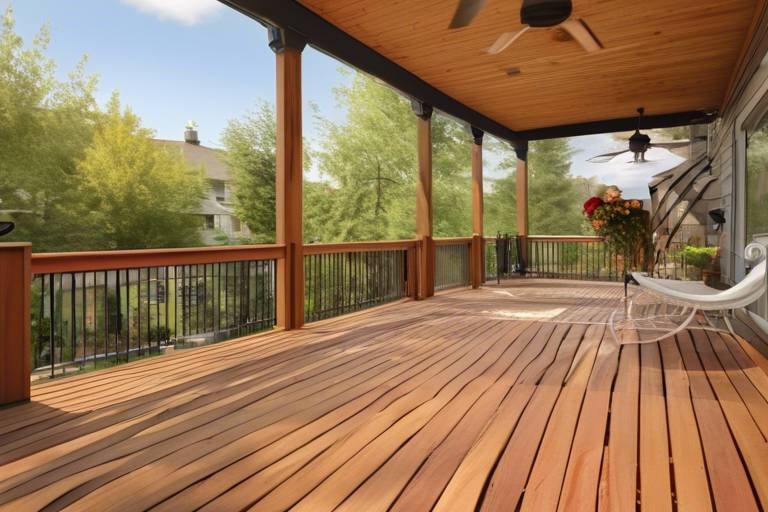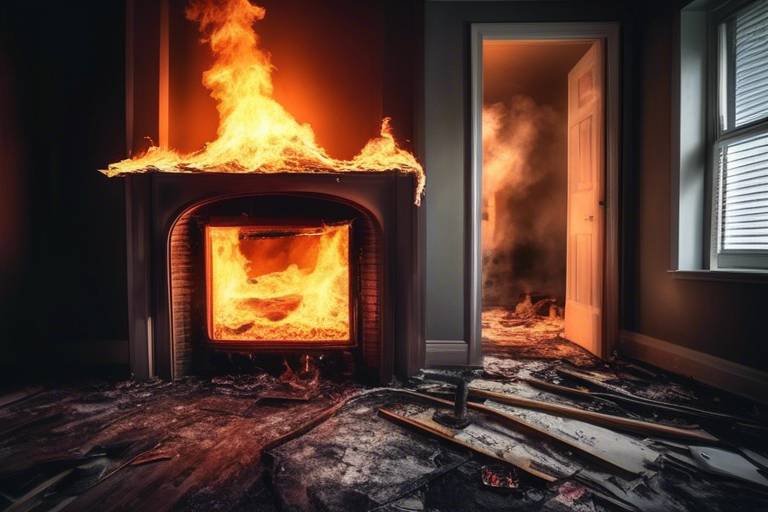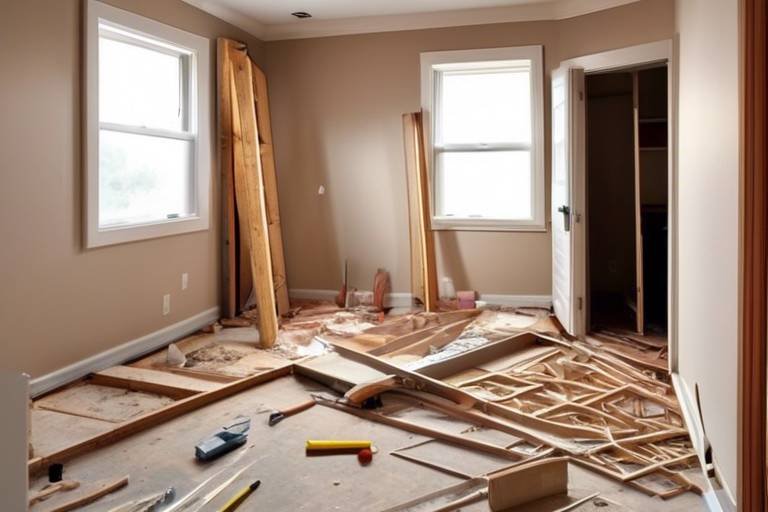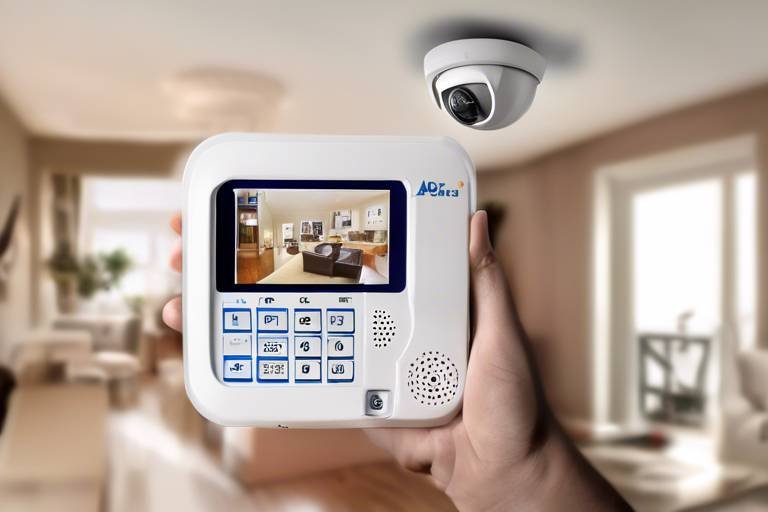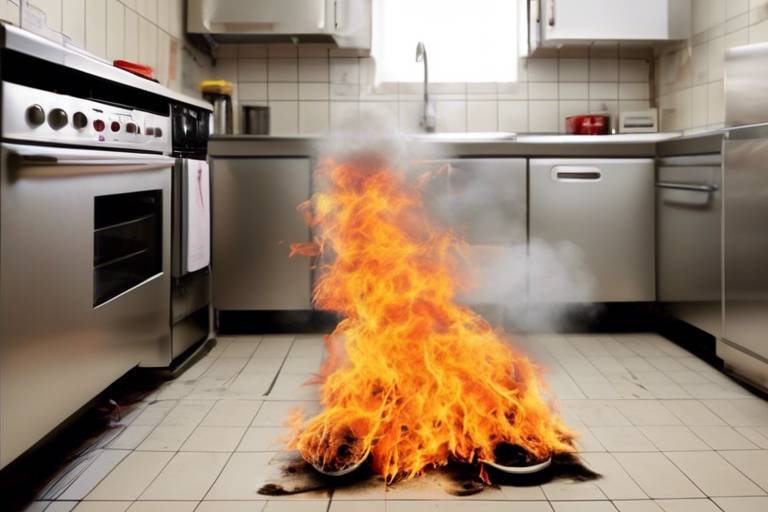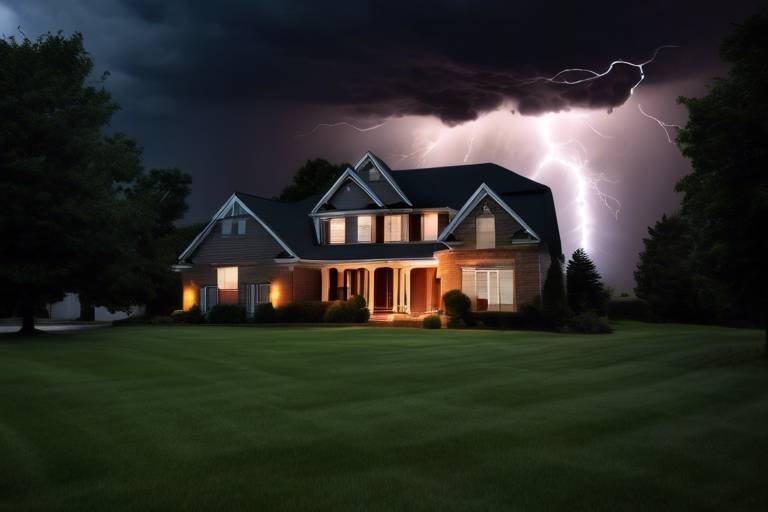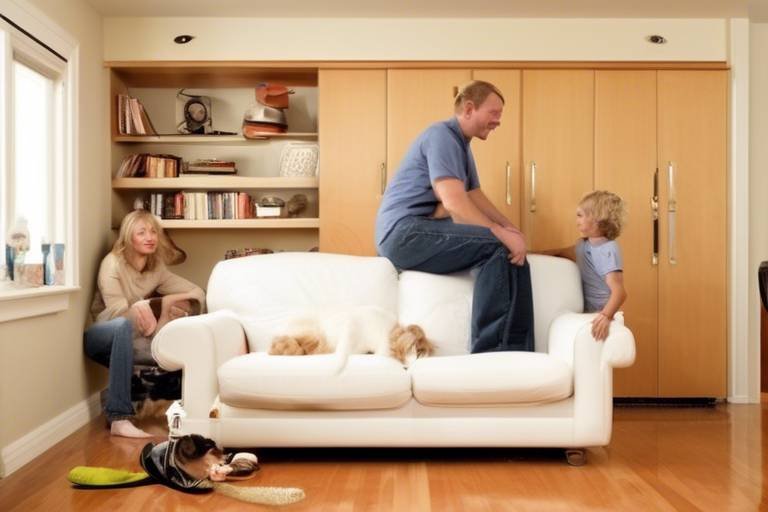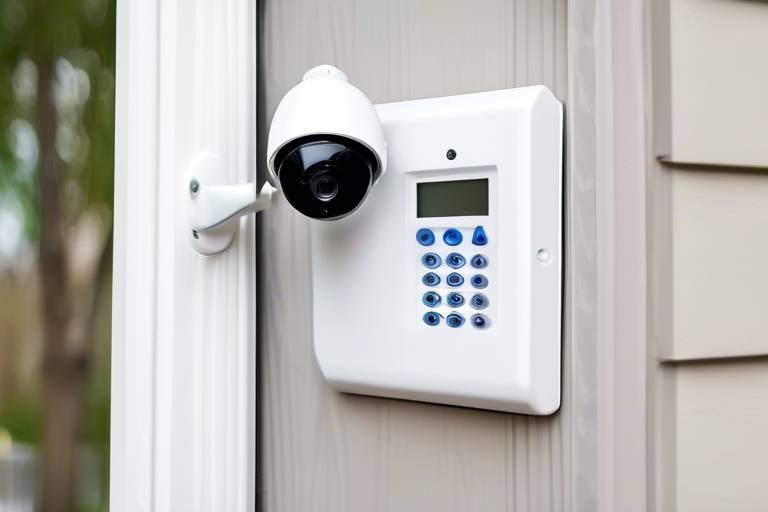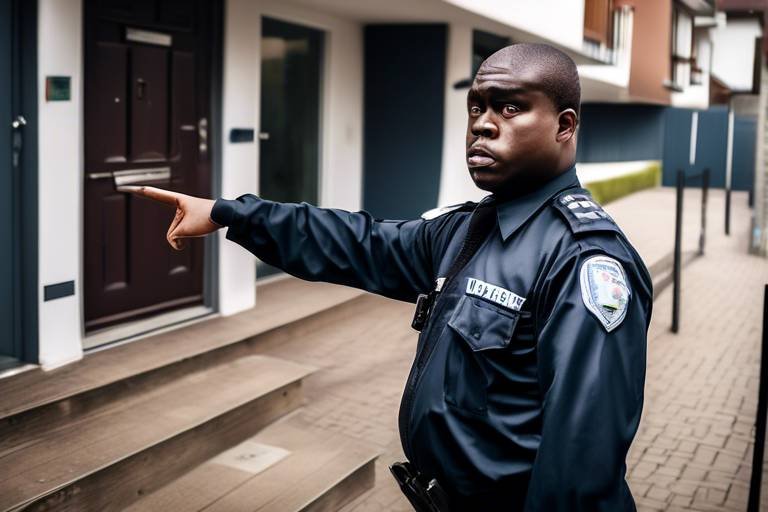What Type of Home Safes Should You Invest In
In today's world, securing your valuables and sensitive documents has never been more critical. With the rise in thefts and natural disasters, investing in a reliable home safe can provide peace of mind. But with so many options available, how do you choose the right one? This article delves into the various types of home safes, their unique features, and essential factors to consider when making your investment. Whether you're looking to protect important documents, jewelry, or other valuables, understanding the landscape of safes can help you make an informed decision.
Understanding the different types of home safes available is crucial for selecting the right one for your specific needs. Home safes come in various forms, each designed to protect against different threats. Here are some common types:
- Fireproof Safes: These safes are designed to withstand high temperatures and protect contents from fire damage.
- Waterproof Safes: Ideal for safeguarding your valuables against flooding or water damage.
- Burglary-Resistant Safes: Built to resist forced entry and theft, these safes offer enhanced security features.
By understanding these types, you can better assess which one aligns with your protection needs. For instance, if you live in an area prone to wildfires, a fireproof safe is a must. Conversely, if flooding is a concern, you might prioritize a waterproof model.
When selecting a home safe, several factors should guide your decision-making process. Size, weight, security features, and fire ratings are just a few elements to keep in mind to ensure your safe meets your specific requirements.
One of the most critical aspects of choosing a safe is understanding its security ratings. These ratings indicate the level of protection against theft and unauthorized access. For example, the Underwriters Laboratories (UL) rating system provides a benchmark for assessing a safe's security. Safes with higher UL ratings offer better protection against various forms of attack. It's worth noting that not all safes are created equal; some may boast impressive features while lacking in actual security ratings.
Burglary-resistant safes are specifically designed to withstand various types of attacks, making them a reliable option for protecting your valuables from theft. These safes often feature reinforced steel construction, complex locking mechanisms, and tamper-proof designs. By investing in a burglary-resistant safe, you're not just buying a box; you're investing in peace of mind.
Fire resistance is another crucial aspect to consider when choosing a safe. The materials used in the construction of a safe can significantly impact its fire rating. Look for safes that have been tested and certified for fire resistance, indicating how long they can protect your contents from extreme heat. For example, a safe rated for 1 hour at 1700°F can keep your documents safe and intact during a fire.
Choosing the right size and capacity of a safe is crucial for accommodating your valuables, documents, and other items. Consider what you plan to store inside the safe. A larger safe may seem appealing, but if it doesn't fit in your designated space or is too heavy to move, it could become more of a hassle than a help. Measure your intended space and consider the dimensions of the safe, ensuring it meets both your storage needs and fits comfortably in your home.
When it comes to home safes, installation options can significantly affect both accessibility and security. You have a few choices:
- Freestanding Safes: These safes offer mobility and ease of access, making them convenient for everyday use.
- Wall-Mounted Safes: These provide a discreet option, often hidden from plain sight, which can enhance security.
- Floor Safes: Similar to wall safes, floor safes are installed into the ground and are typically more challenging to access, adding an extra layer of protection.
Each installation option has its pros and cons. For instance, while a freestanding safe might be easier to access, it can also be more visible and, therefore, more vulnerable to theft. On the other hand, wall and floor safes can be hidden, but they require a more permanent installation.
Freestanding safes are popular due to their mobility and ease of access. However, understanding their placement is essential for maximizing security in your home environment. Placing a freestanding safe in a hidden corner or behind furniture can deter opportunistic thieves. Remember, a safe is only as secure as its location!
Wall and floor safes provide discreet options for securing valuables, often hidden from plain sight. These safes are ideal for added security in your home, as they can be concealed behind a picture frame or under a rug. However, keep in mind that installation can be more complex, and you may need professional assistance to ensure they are correctly fitted.
Q: How do I choose the right size safe?
A: Consider what items you plan to store and measure your available space. It's better to choose a slightly larger safe than to find out your valuables don't fit.
Q: Are all safes waterproof?
A: No, not all safes are waterproof. Be sure to check the specifications and look for safes designed with waterproof features if this is a concern for you.
Q: Can I install a safe myself?
A: It depends on the type of safe. Freestanding safes are often easy to set up, while wall and floor safes may require professional installation for optimal security.

Types of Home Safes
This article explores various types of home safes, their features, and what to consider when investing in one to protect your valuables and sensitive documents.
When it comes to safeguarding your treasures, understanding the different types of home safes available can make a world of difference. There’s no one-size-fits-all solution, and each type of safe offers unique features tailored to specific needs. Whether you’re looking to protect important documents, jewelry, or digital media, knowing your options is key. Here’s a quick breakdown of the most common types of home safes:
- Fireproof Safes: These safes are designed to withstand high temperatures, protecting your valuables from fire damage. They come with various fire ratings, indicating how long they can endure extreme heat.
- Waterproof Safes: Ideal for safeguarding contents from water damage, these safes are especially useful in flood-prone areas or during natural disasters.
- Burglary-Resistant Safes: Built to withstand forced entry, these safes utilize strong materials and advanced locking mechanisms to deter thieves.
- Gun Safes: Specifically designed for storing firearms securely, gun safes often come with additional safety features to prevent unauthorized access.
- Portable Safes: These smaller, lightweight options are perfect for travel or temporary storage, allowing you to keep your valuables secure on the go.
Each type of safe serves a distinct purpose, and your choice should align with your specific needs. For example, if you live in an area prone to wildfires, investing in a high-quality fireproof safe is a no-brainer. On the other hand, if you have a collection of valuable heirlooms, a burglary-resistant safe might be your best option.
Moreover, some safes offer a combination of features. For instance, you might find a safe that is both fireproof and waterproof, providing comprehensive protection against various threats. This versatility can be a game-changer, especially for those who want peace of mind knowing their items are secure against multiple risks.
As you explore your options, consider the size and capacity of the safe. A safe that’s too small will leave your valuables exposed, while one that’s too large might not fit into your designated space. Think about what you plan to store and how frequently you’ll need access to it. This will help you narrow down your choices significantly.
In summary, when selecting a home safe, take the time to assess your specific needs and the types of threats you wish to guard against. By understanding the various types of safes available, you can make an informed decision that will best protect your cherished belongings.
When selecting a home safe, consider factors like size, weight, security features, and fire ratings to ensure it meets your specific requirements and provides adequate protection.
Learn about the different security ratings for safes, including UL ratings, and how they indicate the level of protection against theft and unauthorized access.
Explore how burglary-resistant safes are designed to withstand various types of attacks, making them a reliable option for protecting your valuables from theft.
Discover the importance of fire resistance in safes, including the materials used and the ratings that indicate how long a safe can protect contents from fire damage.
Choosing the right size and capacity of a safe is crucial for accommodating your valuables, documents, and other items while ensuring it fits in your designated space.
Consider the different installation options for home safes, including freestanding, wall-mounted, and floor safes, and how each option affects accessibility and security.
Freestanding safes offer mobility and ease of access, but understanding their placement is essential for maximizing security in your home environment.
Wall and floor safes provide discreet options for securing valuables, often hidden from plain sight, making them ideal for added security in your home.
Q: What is the best type of safe for home use?
A: The best type of safe depends on your specific needs. For general use, a combination of fireproof and burglary-resistant features is highly recommended.
Q: How do I know if a safe is fireproof?
A: Look for safes that have a fire rating, which indicates how long they can withstand high temperatures. Ratings are typically provided by independent testing laboratories.
Q: Can I install a safe myself?
A: Yes, many safes can be installed by homeowners, especially freestanding models. However, wall and floor safes may require professional installation for optimal security.
Q: What size safe do I need?
A: Consider what items you plan to store and choose a safe that accommodates them comfortably while fitting in your available space.

Factors to Consider
When it comes to choosing the perfect home safe, it's not just about picking the first one you see. There are several factors that you need to consider to ensure that your safe meets your specific needs and provides adequate protection for your valuables. Think of it like buying a car; you wouldn’t just grab the first one on the lot without considering factors like size, safety features, and fuel efficiency, right? Similarly, when investing in a home safe, you should take a closer look at aspects such as size, weight, security features, and fire ratings.
First off, let’s talk about size and capacity. You need to ask yourself, “What am I planning to store in this safe?” Whether it's important documents, jewelry, or cash, the size of your safe must accommodate these items comfortably. Imagine cramming a large teddy bear into a small box; it just doesn’t work! So, measure your valuables and consider a safe that not only fits them but also leaves room for any future additions. Also, think about where you’ll place the safe. If it’s too big, it might not fit in your designated space.
Next up is the weight of the safe. Heavier safes are generally more secure because they are harder to move. However, if you plan to relocate your safe frequently, you might want to consider a lighter option. Just like a heavy backpack can be a burden on a hike, a cumbersome safe can be a hassle if you need to shift it around.
Security features are another critical consideration. Look for safes that offer advanced locking mechanisms, such as biometric locks or electronic keypads. These features can provide an extra layer of security, making it harder for unauthorized individuals to access your valuables. In a world where technology is constantly evolving, opting for a safe with modern security features is akin to choosing a smartphone with the latest updates—it's all about keeping your information secure!
Now, let’s not forget about fire ratings. A fire-resistant safe can be a lifesaver in the unfortunate event of a fire. Most safes come with a fire rating that indicates how long they can withstand high temperatures before the contents inside are compromised. For example, a safe with a 1-hour fire rating can protect your documents for up to an hour in extreme heat. This is crucial for safeguarding your most important papers, such as birth certificates, insurance documents, and financial records. In essence, it’s like having an umbrella on a rainy day; it doesn’t prevent the rain, but it does keep you dry!
In summary, when selecting a home safe, consider the following factors:
- Size and Capacity: Ensure it fits your valuables and your space.
- Weight: Heavier safes offer more security but can be cumbersome.
- Security Features: Look for advanced locking mechanisms.
- Fire Ratings: Choose a safe that can withstand fire damage for a significant period.
By keeping these factors in mind, you’ll be well on your way to selecting a home safe that not only meets your needs but also provides peace of mind knowing your valuables are secure.
1. What is the best type of safe for home use?
The best type of safe for home use depends on your specific needs. If you have valuable documents, a fireproof safe is essential. For cash and jewelry, a burglary-resistant safe might be more appropriate.
2. How do I install a home safe?
Installation can vary depending on the type of safe. Freestanding safes can be placed anywhere, while wall and floor safes require more planning. Always follow the manufacturer’s instructions for installation.
3. Can I move my safe once it’s installed?
Yes, but it can be challenging, especially for heavier models. If you plan to move it, consider the weight and the space you have available.
4. How do I maintain my home safe?
Regularly check the locking mechanisms and ensure that the safe is in a dry, cool place. Avoid placing it in areas prone to moisture or extreme temperatures.

Security Ratings
When it comes to safeguarding your valuables, understanding is crucial. These ratings serve as a guide to the level of protection a safe offers against theft and unauthorized access. Most safes are evaluated based on standards set by the Underwriters Laboratories (UL), a trusted organization that tests products for safety and security. The ratings can range from Residential Security Container (RSC) to higher levels like TL-15 or TL-30, which indicate the safe's ability to withstand various forms of attack.
For example, a safe with a UL RSC rating has been tested to resist unauthorized entry for a specific duration, typically around five minutes, using common tools. On the other hand, a TL-15 rated safe can withstand attacks for up to 15 minutes using more advanced tools, making it a more secure option for high-value items. This differentiation is essential for consumers who need to balance their budget with the level of security required for their belongings.
It’s also important to consider that not all safes are created equal. Some safes may offer excellent fire resistance but lack adequate burglary protection. Therefore, when choosing a safe, look for one that provides a comprehensive security rating, which encompasses both fire and burglary resistance. Here’s a quick overview of common security ratings:
| Rating | Description | Protection Level |
|---|---|---|
| RSC | Residential Security Container | Basic protection against unauthorized access |
| TL-15 | Tool-Resistant Safe | 15 minutes of protection against skilled attacks |
| TL-30 | Tool-Resistant Safe | 30 minutes of protection against skilled attacks |
It's a good idea to assess your specific needs: Are you storing important documents, jewelry, or cash? The value and sensitivity of your items should dictate the level of security you require. Additionally, don’t forget to check the safe's construction materials and locking mechanisms, as these factors also contribute significantly to overall security.
In summary, understanding security ratings can empower you to make an informed decision when investing in a home safe. By choosing a safe with a suitable rating, you can ensure that your precious belongings are not just stored, but are truly protected against potential threats.
- What is the best type of safe for home use? - The best type of safe largely depends on what you plan to store. For documents, a fireproof safe is ideal, while for valuables, a burglary-resistant safe may be more appropriate.
- How do I know if a safe is fireproof? - Look for safes that have been rated by UL for fire resistance. These ratings will indicate how long the safe can withstand fire exposure.
- Can I install a safe myself? - Yes, many safes are designed for easy installation, but for larger or more secure options, professional installation might be advisable.

Burglary Resistance
When it comes to securing your most valuable possessions, understanding is absolutely vital. Not all safes are created equal, and some are specifically designed to withstand various types of attacks. Imagine your home as a fortress; would you want to leave the gates unguarded? Burglary-resistant safes act as those fortified gates, providing a robust barrier against intruders. These safes are constructed using high-quality materials and advanced locking mechanisms that make them much more difficult for thieves to breach.
So, what makes a safe burglary-resistant? It’s not just about the thickness of the steel; factors like the locking system, the type of hinges, and even the overall design play a significant role. For instance, many high-quality safes feature:
- Reinforced Steel Construction: Thicker steel panels can resist cutting and prying.
- Advanced Locking Mechanisms: Biometric, electronic, and combination locks offer varying levels of security.
- Anti-drill Plates: These are designed to protect the locking mechanism from drilling attacks.
Moreover, it's essential to pay attention to the safe's security ratings. Reputable safes are often tested and rated by independent organizations, which assess their resistance to burglary. One well-known rating is the Underwriters Laboratories (UL) rating system. Safes with higher ratings have been proven to withstand more severe forms of attack, giving you peace of mind that your valuables are well-protected.
In addition to the physical attributes, consider the location of your safe. A well-hidden safe, perhaps installed in a wall or floor, can be a deterrent in itself. After all, if a burglar can’t find it, they can’t steal from it! Combining a burglary-resistant safe with a clever placement strategy can significantly enhance your home security.
In summary, investing in a burglary-resistant safe is like putting on a strong armor for your valuables. It’s an essential step in safeguarding your possessions against theft. Whether you’re protecting important documents, jewelry, or family heirlooms, knowing what to look for in terms of burglary resistance will help you make an informed decision that aligns with your security needs.
- What is the best type of lock for a burglary-resistant safe? Generally, biometric locks and electronic locks are considered highly secure, but combination locks can also offer excellent protection when used correctly.
- How do I know if my safe is truly burglary-resistant? Look for safes with UL ratings or those certified by other reputable organizations that test their resistance to forced entry.
- Can I install a safe myself? While some safes are designed for easy installation, it's often best to consult a professional, especially for heavier models.

Fire Resistance
When it comes to protecting your valuables, is a feature that should never be overlooked. Imagine losing not only your cherished possessions but also important documents in a devastating fire. A fire-resistant safe can be your first line of defense against such tragedies. These safes are constructed from materials designed to withstand high temperatures, ensuring that your belongings remain intact even in the worst-case scenarios.
Fire resistance is typically measured in terms of time, indicating how long a safe can protect its contents from fire damage. Most reputable safes will come with a fire rating, often expressed in hours. For instance, a safe rated for 1 hour at 1700°F means it can withstand that temperature for an hour without compromising the integrity of its contents. This is crucial for items like passports, birth certificates, and irreplaceable family photos.
It's also important to consider the materials used in the construction of fire-resistant safes. Many manufacturers utilize a combination of steel and fireboard, a type of gypsum board that provides excellent thermal insulation. This combination not only enhances the safe's ability to withstand flames but also protects against the heat that accompanies a fire. Additionally, some safes are filled with special insulating materials that can further increase their fire resistance.
When selecting a fire-resistant safe, look for the following features:
- UL Certification: The Underwriters Laboratories (UL) provides ratings for fire resistance. A UL-certified safe guarantees that it has undergone rigorous testing.
- Fire Ratings: Check the safe's fire rating to see how long it can withstand extreme temperatures. A higher rating generally means better protection.
- Seal Quality: A good fire safe should have a seal that expands when exposed to heat, preventing smoke and heat from entering the safe.
In summary, investing in a fire-resistant safe is not just about securing your valuables; it's about peace of mind. Knowing that your important documents and cherished items are protected from fire damage allows you to sleep soundly at night. So, when you're in the market for a safe, make sure to prioritize fire resistance as a key feature. After all, in the event of a fire, it’s better to be safe than sorry!
Q: How do I know if a safe is fire-resistant?
A: Look for safes that come with a fire rating from a reputable testing organization like Underwriters Laboratories (UL). This rating will indicate how long the safe can withstand high temperatures.
Q: Can I store electronic devices in a fire-safe?
A: Yes, but ensure that the safe is specifically rated for electronic devices. Many fire safes are designed to protect against both fire and water damage, making them suitable for electronics.
Q: What is the difference between a fire-safe and a regular safe?
A: A fire-safe is specifically designed to withstand high temperatures and protect its contents from fire damage, while a regular safe may not have these fire-resistant features.

Size and Capacity
When it comes to choosing a home safe, are two critical factors that cannot be overlooked. Imagine trying to fit your entire collection of important documents, jewelry, and family heirlooms into a safe that’s too small—talk about a recipe for disaster! So, how do you determine the right size for your needs? First, take inventory of what you plan to store. This could include cash, passports, birth certificates, and even your grandmother's antique jewelry. Each of these items has its own unique dimensions, and understanding this will help you make an informed decision.
Next, consider the capacity of the safe. Safes come in various sizes, from small lockboxes that can hold just a few items to larger safes designed to accommodate more extensive collections. A good rule of thumb is to choose a safe with at least 25% more capacity than you think you need. Why? Because as life goes on, you might accumulate more valuables. It’s like buying a car; you wouldn’t want to find yourself cramped for space when you have a growing family or new hobbies that require storage!
To help you visualize the options, here’s a simple table comparing different safe sizes and their typical capacities:
| Safe Size | Typical Capacity | Best For |
|---|---|---|
| Small | 0.5 - 1 cubic feet | Cash, documents, small jewelry |
| Medium | 1 - 3 cubic feet | Multiple documents, jewelry, electronics |
| Large | 3 - 6 cubic feet | Heirlooms, large collections, firearms |
| Extra Large | 6+ cubic feet | Business documents, extensive collections |
Additionally, think about where you plan to place the safe. If it’s going to be tucked away in a closet or a corner of your home, you’ll want to ensure that it fits comfortably in that space. Some safes are designed to be freestanding, while others can be wall-mounted or installed in the floor. The installation option you choose can impact the overall size and capacity you need. For example, wall safes tend to be slimmer, which might limit their capacity, whereas floor safes can offer more space but require a larger footprint.
In summary, selecting the right size and capacity for your home safe is about balancing your current needs with future growth. It’s not just about finding a safe that fits your valuables; it’s about making a wise investment that will protect your treasures for years to come. So, take your time, measure your items, and consider how your needs might evolve. After all, a safe that’s too small is like a house that’s too cramped—no one wants to feel restricted in their own home!
- What is the best size for a home safe? The best size depends on what you plan to store. A medium safe is often a good starting point for most households.
- Can I store large items like firearms in a safe? Yes, but ensure you select a large enough safe designed specifically for firearms.
- How do I know if a safe is fireproof? Look for safes with fire ratings, which indicate how long they can withstand high temperatures.
- Is it better to have a wall-mounted or freestanding safe? It depends on your space and security needs; wall-mounted safes are discreet, while freestanding safes offer more capacity.

Installation Options
When it comes to choosing a home safe, one of the most critical aspects to consider is the . The way you install your safe can significantly impact its security and accessibility. You have three primary choices: freestanding safes, wall-mounted safes, and floor safes. Each option has its own unique benefits and considerations, making it essential to evaluate which type best fits your lifestyle and needs.
Freestanding safes are perhaps the most popular choice due to their mobility and ease of access. These safes can be placed anywhere in your home, making them convenient for quick access to your valuables. However, it’s crucial to think about their placement. For instance, putting a freestanding safe in a visible area might make it easier for you to access but could also increase the risk of theft. If you decide on a freestanding safe, consider positioning it in a less conspicuous spot, perhaps behind furniture or in a closet, to enhance its security.
On the other hand, wall-mounted safes are designed to be installed within the walls of your home, offering a more discreet option for securing your valuables. These safes can be hidden behind pictures or within closets, making them less noticeable to potential intruders. However, installation requires some work, as you’ll need to cut into the wall and ensure proper support. The advantage here is that they take up no floor space and can be easily accessed when needed. Just remember, you’ll want to ensure that the safe is installed at a height that’s comfortable for you to reach.
Lastly, floor safes provide another level of security by being installed directly into the ground. These safes are often hidden beneath carpets or floorboards, making them incredibly difficult for thieves to locate. The downside? They can be challenging to access and may require you to do some digging before you can reach your valuables. However, if you have valuable items that you don’t need to access frequently, a floor safe could be an excellent choice for you.
| Type of Safe | Security Level | Accessibility | Installation Difficulty |
|---|---|---|---|
| Freestanding Safe | Moderate | Easy | Low |
| Wall-Mounted Safe | High | Moderate | Medium |
| Floor Safe | Very High | Low | High |
Ultimately, the choice of installation will depend on your personal preferences and the level of security you desire. Think about your daily routine and how often you need to access your safe. If you find yourself needing quick access to important documents or valuables, a freestanding safe might be the way to go. However, if you’re looking for a more secure option that’s out of sight, consider wall or floor safes. Your home is your sanctuary, and protecting it should be a top priority.
Q: What is the best type of safe for home use?
A: The best type of safe depends on your specific needs. If you need easy access, a freestanding safe is ideal. For discreet storage, consider wall-mounted or floor safes.
Q: How do I ensure my safe is secure?
A: Look for safes with high security ratings, install them in less visible areas, and consider bolting them to the floor or wall for added security.
Q: Can I install a safe myself?
A: Yes, many safes, especially freestanding ones, are easy to install. However, wall and floor safes may require professional installation for optimal security.

Freestanding Safes
When it comes to securing your valuables, are a popular choice that combines mobility with accessibility. Imagine having a fortress for your cherished items that you can easily move if needed. These safes stand independently on the floor, making them easy to access while offering robust protection against theft and damage. However, it’s essential to consider their placement carefully to maximize security. Just like a knight guarding the castle gates, the right positioning can make all the difference.
One of the greatest advantages of freestanding safes is their versatility. They can be placed in various locations within your home, whether it’s in a closet, basement, or even a home office. However, this flexibility also requires a strategic approach. For example, placing a safe in a less visible area can deter potential thieves, while ensuring it’s still accessible to you when needed. Think of it as a game of hide and seek, where your valuables are the ones hiding, and you’re the only one who knows their secret location!
In terms of security features, many freestanding safes come equipped with advanced locking mechanisms, including digital keypads, biometric locks, or traditional key locks. These features not only enhance security but also make it easier for you to access your items quickly. Imagine rushing to grab important documents or jewelry in a pinch; a reliable locking mechanism can save you precious time. Additionally, some models are designed to be fireproof and waterproof, providing an extra layer of protection against unexpected disasters.
However, it’s important to note that while freestanding safes are convenient, they can also be more susceptible to theft if not secured properly. To counter this, consider bolting the safe down to the floor or wall, which can significantly increase its resistance to removal. This is akin to anchoring a ship in a storm; it’s not just about having a sturdy vessel, but also ensuring it stays put amidst turbulent conditions.
When selecting a freestanding safe, you’ll want to consider the following factors:
- Size and Capacity: Make sure the safe is large enough to accommodate your valuables, but also fits comfortably in your chosen location.
- Weight: Heavier safes are generally more secure, but they can also be more challenging to move.
- Security Features: Look for safes with solid construction and reliable locking mechanisms.
- Fire and Water Resistance: If you live in an area prone to natural disasters, consider safes that offer additional protection against these elements.
In conclusion, freestanding safes are an excellent investment for anyone looking to protect their valuables while maintaining ease of access. With the right features and placement, they can serve as a stronghold for your most prized possessions. Just remember, the key to maximizing their potential lies in thoughtful selection and strategic positioning. So, are you ready to fortify your home with a freestanding safe?
1. How do I choose the right size for a freestanding safe?
Consider what items you plan to store and their dimensions. It's wise to select a safe that offers a bit of extra space to accommodate future needs.
2. Can I install a freestanding safe myself?
Yes, most freestanding safes are designed for easy installation. However, for added security, bolting it down is highly recommended, which may require professional assistance.
3. Are all freestanding safes fireproof?
No, not all freestanding safes offer fireproof features. Be sure to check the specifications and look for safes that have been tested for fire resistance.
4. What is the best location for a freestanding safe?
Ideally, choose a location that is discreet yet accessible, such as a closet or a hidden corner of a room. Avoid placing it in easily visible areas that could attract unwanted attention.

Wall and Floor Safes
When it comes to securing your valuables, are like hidden treasures in your home. Imagine having a safe that not only protects your important documents and valuables but also keeps them out of sight from prying eyes. These safes are designed to be discreet, allowing you to hide them in walls or under floors, making them an excellent choice for those who value both security and aesthetics.
One of the biggest advantages of wall and floor safes is their space-saving design. Unlike traditional freestanding safes that can take up significant floor space, these safes can be installed in tight spots, such as behind a picture frame or under a rug. This means you can maximize your living area while still ensuring your prized possessions are well-protected. Moreover, their hidden nature makes them less appealing to burglars, who often target easily accessible safes.
Another factor to consider is the installation process. Wall safes typically require cutting into drywall, while floor safes may necessitate digging into the concrete or flooring. It's essential to ensure that the installation is done correctly, as a poorly installed safe can compromise its security. Many homeowners opt to hire professionals for this task, ensuring that the safe is both secure and aesthetically pleasing.
When selecting a wall or floor safe, you should also consider its security features. Look for models that offer advanced locking mechanisms, such as electronic locks or biometric fingerprint scanners. These features not only enhance security but also provide convenient access for you and your family. Some safes even come with alarms that alert you to unauthorized access attempts, adding an extra layer of protection.
Moreover, it’s vital to think about the safe's fire and water resistance. Just because a safe is hidden doesn’t mean it should be vulnerable to natural disasters. Opt for safes that have been tested for fire and water resistance, ensuring that your documents and valuables remain intact in the event of an emergency. Many manufacturers provide ratings that indicate how long the safe can withstand extreme heat or flooding, so be sure to check these specifications.
In conclusion, wall and floor safes are an excellent investment for anyone looking to enhance their home security. Their discreet design, combined with robust locking mechanisms and disaster resistance, makes them a formidable choice for protecting your valuables. So, if you’re ready to take your home security to the next level, consider adding a wall or floor safe to your arsenal!
- Are wall and floor safes easy to install? - Installation can be tricky and may require professional help to ensure they are securely mounted.
- Can I access my wall or floor safe easily? - Yes, as long as you choose a model with a user-friendly locking mechanism.
- What items should I store in a wall or floor safe? - Important documents, jewelry, cash, and other valuables are ideal for these safes.
- Do wall and floor safes come with fire and water resistance? - Many models offer these features, but it's essential to check the specifications before purchasing.
Frequently Asked Questions
- What is the best type of home safe for protecting documents?
When it comes to protecting important documents, a fireproof safe is your best bet. These safes are designed to withstand high temperatures, ensuring that your papers remain intact even in the event of a fire. Look for safes with a high fire rating, which indicates how long they can protect contents from fire damage.
- Are waterproof safes worth the investment?
Absolutely! If you live in a flood-prone area or just want to safeguard your valuables from unexpected water damage, a waterproof safe can be a lifesaver. These safes are designed to keep your items dry, even when submerged. Just make sure to check the safe's waterproof rating to ensure it meets your needs.
- How do I choose the right size safe for my home?
Choosing the right size safe depends on what you plan to store. Consider the volume of items like documents, jewelry, and electronics. Measure your space and think about the capacity you need. A safe should comfortably hold your valuables without cramming them in, allowing for easy access.
- What security features should I look for in a safe?
When selecting a safe, look for features like a digital keypad, biometric locks, or traditional key locks. It's also important to consider the safe's security ratings, such as UL ratings, which indicate the level of protection against theft. A combination of features can provide a robust defense against unauthorized access.
- Can I install a safe myself, or should I hire a professional?
It really depends on the type of safe and your comfort level with installation. Freestanding safes are usually easy to set up on your own, while wall-mounted or floor safes may require some professional help to ensure they are securely installed and not easily accessible to intruders.
- What is the difference between a burglary-resistant safe and a regular safe?
A burglary-resistant safe is specifically designed to withstand various types of attacks, such as drilling or prying. These safes often have thicker steel walls and advanced locking mechanisms compared to regular safes. If theft is a concern, investing in a burglary-resistant safe is a smart choice.
- How can I ensure my safe is secure?
To maximize the security of your safe, choose a discreet location that is not easily visible to outsiders. Additionally, consider bolting your safe to the floor or wall, which makes it much harder for thieves to remove it. Regularly change your access codes and keep the keys in a secure place.



